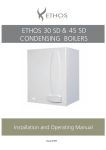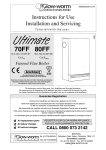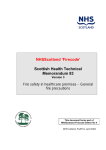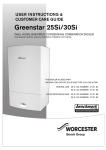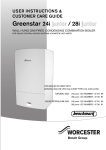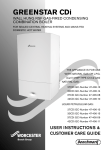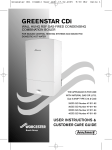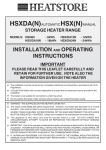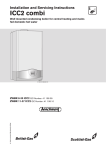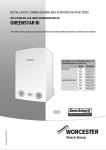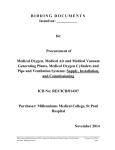Download OPERATING INSTRUCTIONS - Searched Google for Boilermanual
Transcript
OPERATING INSTRUCTIONS Some householders hold the belief that by turning down the boiler temperature that they save fuel. Generally speaking, however, the boiler remains on longer as the heat transfer to the dwelling, through the radiators, is diminished and the boiler merely cycles longer. On the other hand if the temperature is set too low it is possible to create condensation within the boiler which could be deleterious. Therefore you are advised to leave the setting between 3 and 4. Section 1. Operating Instructions 1.1. Introduction 1.2 The Control Thermostat 1.3 High Limit Thermostat 1.4 Lock Out Button 1.5 Sealed Systems - Applies to Combi and System Appliances 1.6 Water Systems - Combi and System Appliances 1.7 Filling the System 1.8 Oil 1.9 Fault Finding 1.10 Servicing 1.11 Guarantee 1.12 How Grandee Combi Works 1.13 The Control Thermostat - Combi Appliances only 1.14 System Boilers 1.15 Hot Water Control Knob 1.16 Radiator Valves 1.17 Cold Water Supply 1.18 Taps and Showers 1.19 Thermostatic Radiator Valves 1.20 Bypass or Differential Pressure Valves In the case of combi appliances the temperature of the primary water also influences the temperature and quantity of domestic hot water. The higher the temperature of the primary water, the greater the value of the built in heatstore or thermal value. Also the hotter the primary water, the better is the transfer of heat to the domestic water through the ‘plate’ heat exchanger. For optimum amount of hot water set the control thermostat to the highest figure. Finally, the hotter the domestic hot water leaving the boiler, prior to the mixing valve, the greater the volume of domestic hot water reaching the tap. This is because, in these circumstances, more cold water is mixed with the hot water necessary to modulate the temperature of the water flowing through the tap or shower. Summary:- Turn the control stat to maximum for hottest radiators and hotter/more domestic hot water. The cooler the primary water the cooler the radiators and cooler/less domestic hot water. Our recommendation is - set at maximum. 1.3 High Limit Thermostat 1.1 Introduction In the event that the operating thermostat should fail, a high limit thermostat is fitted as a safety precaution. This is designed to protect the boiler from overheating. Should the high limit thermostat be required to operate then the red light on the control panel will illuminate. To reset the high limit thermostat press the red button. It would be advisable to consult your service engineer if your red light illuminates. Your Grandee oil boiler is designed and manufactured to the highest engineering standards known to us and should give long and satisfactory service if installed, commissioned and serviced correctly. All Grandee appliances are fully automatic and capable of producing heat for hydronic central heating systems, both sealed or open vented, and for domestic hot water. Your heating engineer should be capable of calculating and fitting the necessary equipment for your central heating system and the incorporation within the system of your Grandee appliance. 1.4 Lock Out Button In the event that the burner should fail, for a variety of reasons, the lock out button will illuminate. E.g., if you run out of oil or if a control fails. This is a signal to you that something is malfunctioning. You may press this reset button and the boiler may fire satisfactorily. If you decide a further attempt allow at least 2 minutes to permit the control box to go through its proper sequence. If after 2 or 3 attempts your boiler fails to fire then consult your service engineer. The lock-out button is located as indicated on the illustrations in Fig. 1. In essence, your Grandee boiler will respond to its instructions, that is, it will switch on and off when the control devices, normally a programmer or time clock, direct it to. Heating World do not supply programmers or time clocks and your heating engineer will explain the operation of the type supplied to you. As far as your Grandee boiler is concerned there is very little for you to concern yourself with but it will be helpful to understand the following: Grandee Wall Mounted Grandee Floor Standing 1.2 The Control Thermostat This is the control knob which can regulate, within the band 50 80ºC, the temperature of the boiler water, known as primary water, which is the water which runs through your radiators and heating system. You are, therefore, able to adjust the temperature at which the primary water leaves the boiler. The graduations on the thermostat knob rise/fall in increments of approximately 5ºC. Normally we would expect the knob to be set around graduations 3 or 4 which correspond to approximately 75ºC. Fig.1 Beneath the boiler on the right hand side 3 On front panel OPERATING INSTRUCTIONS Central Heating Expansion Vessel This vessel is designed for a maximum system capacity of 130 litres (28.5 gallons). The contents of the Grandee Combi and System Boilers must be deducted from the totals as follows. 1.5 Sealed Systems - applies to Combi & System appliances A minimum pressure is required for your Grandee Combi/System to operate properly which can be viewed on the pressure gauge located in the front panel of the appliance. Grandee SW 15/20 Grandee SW 20/24 Grandee SW 24/27 Grandee SFS 15/23 Grandee SFS 20/25 Grandee SFS 25/29 Recommended pressures are:1.25 bar cold Up to 2.5 bar when hot. The actual pressure will depend on the temperature and the amount of water in the heating system. If the pressure drops below this minimum level the system should be re-pressurised. less less less less less less 50 litres 45 litres 45 litres 60 litres 60 litres 45 litres (11 gallons) (10 gallons) (10 gallons) (13 gallons) (13 gallons) (10 gallons If the volume of water in the central heating system exceeds 50 litres (11 gallons) then an auxiliary expansion vessel will be needed in compliance with BS4841. This should be fitted as near to the central heating return connection on the heat-exchanger and charged at an equal pressure to the factory filled expansion vessel. For further information consult BS7074 part 1. If your system repeatedly loses pressure then there is probably a leak in the system which needs rectifying. Sometimes loss of pressure from a sealed system can be caused by poor quality and ineffective radiator valves. Where the central heating supply is fully heated and the pressure does not exceed 2.5 bar then the factory fitted expansion vessel is sufficient.) 1.6 Water System - Combi & System appliances Expansion Vessel Pressure The heating system must comply with BS5499 and BS6798 Standards. Maximum domestic hot water temperature must not exceed 86˚C. The mixing valve, however, ensures a maximum hot water temperature of 70˚C and, therefore, the maximum temperature is substantially under the maximum permitted under BS Standards. Grandee Combi and System appliances are designed for sealed central heating systems with contents up to 50 litres. When filled COLD the recommended system pressure should be approximately 1.25 BAR which equates to the maximum static head of the system. All plumbing fittings are designed to operate up to 3 bar which is the maximum pressure of the system. Any extra fittings supplied by the installer should, similarly, be capable of operating up to 3 bar pressure. The system pressure, when on maximum temperature of 80ºC (see section 1.13 The Control Thermostat) should not be more than about 2.5 bar. If the pressure is set near or on 3 bar then the pressure relief valve will activate indicating that the system is over-pressurised. An expansion vessel of 10 litre capacity is also incorporated. If the central heating system, excluding the boiler, exceeds 85 litres volume then a further expansion vessel will be necessary to cope with the additional volume/expansion. Grandee Wall Combi and System boilers are factory fitted with a DRAIN-OFF COCK which is located beneath the heat-exchanger. Grandee Floor Combi and System boilers have the drain-off cock located bottom front right hand of the heat-exchanger. The system pressure can be checked by heating the central heating system to maximum temperature and checking the pressure on the pressure gauge provided. If the pressure is less than 2.25 bar then the system will be satisfactory. If the pressure exceeds 2.5 bar then a supplementary expansion vessel should be installed to cater for the additional expansion. This should be fitted as reasonably close as possible to the central heating return connection on the boiler ensuring compliance with BS4841 and BS7074 part 1. Poor quality radiator valves are often responsible for loss or leakage from the central heating system and high quality valves which comply with BS2767 (10) 1972 are recommended. Heating World can supply suitable radiator valves if required. 1.7 Filling the System Grandee Combi and System appliances are designed for sealed systems and must be installed by a competent, preferably OFTEC approved, engineer. Ensure that systems are properly flushed and that all debris, fluxes and foreign matter is cleared from the system. This is particularly important on old central heating systems where corrosion debris, scale and sludge has accumulated. Reduced circulation through restriction and blockages can cause premature corrosion of the heat exchanger as well as damaging components. Heating World manufacture a top quality central heating protection and cleaning system. The system can be filled by:A make up by pre-pressurisation of the system using a temporary hose connection in conjunction with a stop valve and non return, double-check valve. DO NOT connect directly to the mains supply. Consult your Local Water Authority if in doubt. 4 OPERATING INSTRUCTIONS You MUST have your boiler correctly installed and commissioned otherwise your manufacturers warranty will be rendered null and void. Water Supply & Flow Rate - Grandee Combis only Mains fed combi boilers share the available water with various devices such as taps, dishwashers and cisterns etc. The flow of water can be reduced if other such devices demand water simultaneously. This is quite normal and you are likely to experience this phenomenon as when several cold taps are turned on at the same time. If the mains water pressure supply is low or long 15mm pipe runs are involved from mains to boiler then larger diameter pipework may have to be fitted. In hard water areas, that is where the temporary hardness exceeds 100 p.p.m, scale can build up in the ‘plate’ heat exchanger, and may eventually block it completely. In these circumstances an in line scale inhibitor must be fitted. Replacement of the plate heat-exchanger is a simple matter, however. Consult your local water company to determine the hardness of water in your area. Ensure that a copy of OFTEC form CB10 is left with you to prove that your appliance has been commissioned by an OFTEC engineer. Whereas we shall do our best to advise and assist you in remedying any problems which may arise, if you cannot produce commissioning data a charge will be made for the call out payable at the time of the visit. The manufacturer reserves the right not to inspect an appliance that has not been commissioned. Before a call is made to site by the manufacturer payment or a credit card transaction will be required. If the appliance has failed under warranty through faulty manufacture or components then a credit or cheque in repayment will be issued without delay. This procedure has been introduced because the manufacturer has made numerous site visits or abortive calls resulting from faulty installations or such as running out of oil, fire valves faulty etc, etc. 1.8 Oil Your Grandee oil appliance is designed to burn Kerosene 28º Class 2-BS2869. SUMMARY: The manufacturer will pay for parts and labour if equipment fails through faulty manufacture on equipment during the warranty period. The manufacturer will not pay for either installation or operating faults. Try to keep your oil storage tank replenished as sludge and debris could damage your burner. Also, if you run out of oil it can be expensive to call out an engineer to bleed air from the oil line and reset the burner. 1.9 Fault Finding Notes are provided in Section 11 of this manual but please take note of the following points. 1.11 Guarantee Subject to correct installation, commissioning and servicing, your Grandee boiler has a twelve month warranty. Nozzles and associated problems are excluded from the manufacturers warranty. You may extend this warranty for up to five years for the payment of a modest insurance premium. See details supplied separately. Check the electric supply and that no fuses a). are blown. If a fuse fails more than once this means that there is a problem and you electrishould consult your service engineer or an a n y cian. Do not tamper with electric under circumstances. We hope you are happy with your Grandee appliance which should give you many years of satisfactory service. b). Do not press the reset (lock out) button more than three times and ensure you delay at least three minutes before each attempt or you risk damaging the control box. c). Check that you have not run out of oil. Important Ask your service engineer to complete the enclosed installation and commissioning form. If this is not completed it is likely that your appliance has not been commissioned and will not operate correctly. d). Check that the orange light is illuminated to denote that there is a power supply to your appliance. 95% of calls to site are not associated with the boiler itself. Therefore, ensure that the boiler is installed and commissioned correctly before calls to manufacturer for assistance are made. 1.10 Servicing Helpline You are advised to have your boiler regularly serviced by a qualified, preferably OFTEC trained, engineer. With kerosene burning appliances service at least once yearly. Telephone 0121 454 2244 for advice. We want to help you and your installer. A short telephone call can avoid problems. 5 OPERATING INSTRUCTIONS ed by the boiler over a period of 30 minutes to one hour. The hot boiler water (primary water) is circulated through a coil inside the copper cylinder and gradually heats the stored water. This coil is a relatively poor heat-exchanger because: Extra notes for Grandee ‘Combi’ appliances 1.12 How Grandee Combi Works Grandee Combi incorporates a high-tech boiler, similar in principle to most oil-fired boilers, which comprises an ultra compact heat-exchanger and pressure jet burner. This boiler heats water, known as primary water, which circulates through radiators for central heating. a). It has limited surface area. b). There is no laminer flow or ‘scrub’ over its surface (itself a big factor in heat transfer). c). The temperature differential between the primary water and the stored water progressively decreases thereby ever reducing heat transfer. So no matter how big the boiler output, it takes up to an hour to heat a reasonable amount of hot water. d). And then the water stratifies so the entire contents of the cylinder are not the same temperature. The appliance also embodies a high efficiency plate heatexchanger which transfers heat from the primary water to the domestic water directly from the mains, thus providing hot water at mains pressure. Within the appliance are components such as circulating pump, heating system expansionvessel, water temperature control valve and such other controls which you would expect to find in a well designed, efficient modern heating system. Yet with Grandee Combi all this is extremely compact and beautifully, though simply engineered. No need for copper cylinders, tanks of water in the loft, and long heat-wasteful pipe runs. Poor showers are a thing of the past. Grandee Combi is the finest range of oil combination boilers available featuring several ingenious and patented innovations. When a large amount of hot water is drawn, however, for example a bath load, this stored water can be drawn off quickly, but once drawn off a delay of up to one hour occurs before another supply can be drawn off. Some householders are accustomed, however, to the relatively generous supply of hot water once the copper cylinder is heated. In contrast, a combi heats water relatively instantaneously and the actual amount of hot water available will be related to the output of the boiler. The bigger the output the more hot water. Combis and hot water - Better but different Grandee Combi boilers produce hot water in a different manner from traditional systems with copper cylinders. An understanding of the principle will enable you to obtain optimum results for your appliance and realise your level of expectation. With Grandee Combi a carefully calculated thermal store of primary water is built into the appliance so as to supplement the burner output. This thermal store takes between 5 and 20 minutes to ‘charge’ dependent on the boiler output and its thermal value can vary according to its temperature. The hotter the thermal store, the larger the battery. However, if the amount of water being drawn off should ‘overtake’ the boilers ability to produce heat the temperature of the hot water will fall. A simple remedy is to turn the tap down (reduce the flow rate) in such a way as to restrict the flow. But then, unlike the copper cylinder method, the hot water will flow indefinitely. So what is the main difference? Grandee Combi heats cold water directly from the mains by transferring heat in the boiler (primary water) to the incoming cold mains (domestic) water by means of a highly efficient ‘plate’ heat-exchanger. The advantages of the system are: a). Hot water is delivered at mains pressure (regardless of flow-rate) which means that wonderful pressure can be delivered for showers. Typical mains pressure can be 30 - 50 p.s.i. compared with say 5 - 10 p.s.i. from a storage tank in the roof (each 2.3 feet of ‘head’ produces merely 1 p.s.i.). b). The hot water is potable - that is, it is fresh from the mains like the cold supply and has not passed through storage tanks in the roof or a copper cylinder. c). It is more economical and more efficient to produce hot water by this means rather than the old copper cylinder method. d). Hot water can be produced indefinitely provided that the flow rate is equated to the boiler output. In order to reduce the possibility of excessive water flow, each Grandee Combi incorporates a built in flow regulator, carefully sized according to the output of the appliance, in order to stabilise the delivery of hot water. This flow regulator also enhances the performance of its various control thermostats and mixing valves within the appliance which perform better when less subjected to extreme and sudden changes of volume and temperature. Summary: Grandee Combi produces hot water much more efficiently than the old fashioned copper cylinder method with a number of other advantages. It is as well to think of them as larger versions of electric or gas instantaneous water heaters and that if the hot water flow is excessive then the temperature of the hot water will fall. So what are the disadvantages? In our opinion there are no disadvantages once you understand how a combi works and know what to expect of it. Most criticisms of combi boilers relate to the hot water production. In a ‘copper cylinder’ method - the cylinder is gradually heat- 6 OPERATING INSTRUCTIONS you to exercise control of the hot water temperature. The lower the temperature setting the greater is the volume of hot water delivered but this thermostatic control valve is useful where young children or infirm people are involved as excessively hot water can be avoided without reliance upon alternative control devices. The coolest water is available on setting 1 and the hottest on setting 5 (see Section 1.13). Normally your installer will adjust this to your preferred setting. 1.13 The Control Thermostat Combi appliances only This is the control knob which can regulate, within the band 50 - 75ºC, the temperature of the boiler water, known as primary water, which is the water which runs through your radiators and heating system. You are, therefore, able to adjust the temperature at which the primary water leaves the boiler. Some homeowners prefer very hot water whereas others, particularly where children, old or infirm are involved, prefer lower temperatures through their radiators. Turn anti-clockwise to reduce primary water temperature, clockwise to increase. The temperature of the primary hot water is not the final determinant of the domestic hot water temperature which can be adjusted by the grey hot water control knob. See Section 4.8. Normally we would expect the knob to be set between graduations 3 and 4 which corresponds to approximately 65-70ºC. From a cold start Grandee Combi Compact takes up to 20 minutes to adequately heat its thermal store. The bigger the thermal output the faster the appliance is ready to provide hot water. In normal usage the appliance is seldom stone cold and, therefore, the appliance will normally produce hot water in 10 minutes or so. If your system incorporates a time clock or programmer it would be prudent to time your Grandee Combi to switch on approximately 20 minutes before you are likely to require domestic hot water to ensure that it is fully ‘charged’. 1.16 Radiator Valves Leakage from a sealed system which requires constant replenishment, introduces fresh water and, thereby, corrosion into the heating system which is undesirable. Use suitable valves, connections and high quality radiator valves which comply with BS.2767:10 to avoid such loss of water. 1.17 Cold Water Supply Whenever possible use 22mm pipe from the cold water mains supply to the appliance and first hot water outlet to maximise the flow rates to the various draw off points. Constant volume flow regulating or balancing valves may be required to avoid water starvation to individual taps. 1.18 Taps and Showers Ensure that all taps and shower heads are compatible for mains pressure operation. Single-lever taps are particularly suitable for Grandee Combi appliances. Shower heads must not be immersed in bath water and should be held a minimum distance of 25cm above the bath. Otherwise a double-check valve must be fitted to present anti-syphonage to the domestic water supply. 1.14 System Boilers 1.19 Thermostatic Radiator Valves Grandee System boilers are a type of intermediary appliance between ‘Combi’ and ‘Standard’ models. A System boiler is sealed by means of an expansion vessel contained within the casing of the appliance and which enables expansion and contraction of the primary water in the heating cavity thereby eliminating the feed and expansion tank usually located in the loft of the dwelling. Where a central heating system is equipped with thermostatic radiator valves, a suitable bypass or differential pressure valve MUST be fitted. It is not sufficient to leave a small radiator with open valves which risk being closed by the householder at certain times (i.e. summer months). Failure to fit a suitable bypass can cause stratification of primary water in the heat exchanger and may trigger the high limit thermostat. Also, the circulating pump may be damaged or burned out if it is prevented from performing normally. Stratification of primary water can create vapour pressure, impede the circulating pumps’ performance and cause cavitation. Sealed systems should only require occasional replenishment once the system is filled and should reduce any potential for internal corrosion of the heating system. System boilers also contain the circulating pump within the boiler casing as well as a pressure gauge and pressure release valve. 1.20 Bypass or Differential Pressure Valves 1.15 Hot Water Control Knob (Grey) Combi appliances only Ensure that your heating system is fitted with a suitable bypass especially where thermostatic radiator valves are used or where zoning valves or other circuit controls are fitted within the system. This knob adjusts, thermostatically, the temperature of the domestic hot water by rotating clockwise (cooler) or anticlockwise (hotter). Its temperature range is approximately 30 to 70ºC regardless of the temperature of the primary water (see The Control Thermostat, Section 1.13) this valve enables 7






